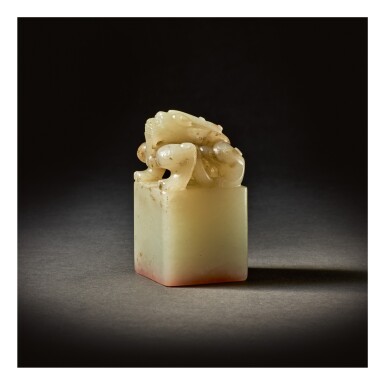
AN IMPORTANT AND RARE IMPERIAL WHITE AND BEIGE JADE 'CHILONG' SEAL, QING DYNASTY, DAOGUANG PERIOD
Auction Closed
September 22, 03:56 PM GMT
Estimate
200,000 - 300,000 USD
Lot Details
Description
AN IMPORTANT AND RARE IMPERIAL WHITE AND BEIGE JADE 'CHILONG' SEAL
QING DYNASTY, DAOGUANG PERIOD
清道光 白玉雕螭龍鈕方璽
of square section, surmounted by a single-horned dragon crouching on four-clawed feet with its head facing forward, detailed with a pointy beard and protruding eyes above a slightly upturned snout, its long mane trailing over its compressed body with a bifurcated tail curling under its left rear leg, the seal face carved in baiwen style with four characters reading Shendetang bao (treasure of Shendetang), the softly polished stone with specks of brown inclusions
Height 2⅜ in., 5.9 cm; Width 1⅛ in., 3 cm; Depth 1⅛ in., 3 cm
璽文:
慎德堂寶
Collection of Stephen Junkunc, III (d. 1978).
來源
史蒂芬•瓊肯三世(1978年逝)收藏
This exquisite seal embodies the special significance of the luxurious Shende Tang (Hall of Prudent Virtue) to the Daoguang Emperor. The 1824 review of the Yuanming Yuan upon his ascendancy to the throne showed notable surplus, thus enabling him to construct this building as the new royal living quarters in 1830 on the Nine Continents in the Yuanming Yuan. Completed in 1831, the Shende Tang showed a distinct character and greater freedom in its design and arrangement, departing markedly from the more Confucian-inspired architecture. For example, the hall featured three connected undulating roofs on a square-shaped structure, expressing in a lively manner the unique character of Chinese garden art. This seal was produced between 1831 and 1850 to be housed in and to celebrate the Emperor's beloved Shende Tang. The importance of this residence is further evidenced by a large square Shende tang bao seal seen impressed on two portraits of the Daoguang Emperor, Daoguang Di Xingle Tu and Xiyi Qiuting Tu.
The name Shende Tang reveals the importance of virtue to the Daoguang Emperor. Dayumo, a character in Shangshu noted that 'Virtue is in good government, and the key to good government lies in nourishing the common people'. Yu states that a ruler should try his best to maintain social harmony, and the key to this is to educate the people in ethics through culture, to devote resources to their use, and to establish official systems to improve their livelihood. Yu's principle was observed by Chinese rulers throughout history and was adopted as an official policy by the Qing emperors. The Kangxi, Qianlong and Jiaqing Emperors all extolled of this principle, as did Daoguang, who believed that 'virtue and government are the inner and outer aspects of the same, and government and the common people respond to each other'. However, repeated defeats by foreign powers and social unrest prevented him from accomplishing many of his goals.
Due to the economic frailty of the Qing empire and the Daoguang Emperor's own frugality, only approximately 60 imperial seals were created during his reign. Nonetheless the method of production followed in the same format, whereby the Imperial Household Workshops would create designs according to the seal texts selected by the Emperor. Once the designs were approved by the Emperor, the seal was created, and again had to be approved by him. As a result, Daoguang's imperial seals maintain the quality and stylistic vitality of his predecessors, as evidenced by the lively sculptural quality and conscientious craftmanship of the present seal, as well as the intricacy and fluency of its calligraphic inscription.
Compare a smaller pair of celadon and brown jade seals, similarly carved with crouching mythical beasts, one seal face reading Daoguang yubi ('treasure inscribed by the hand of the Daoguang Emperor'), and the other reading Zhengzai yangmin ('the way of governance lives in nurturing people'), from the collection of Emile Guimet, sold in our Hong Kong rooms, 1st-2nd June 2017, lot 577. Three further small white jade seals of the Daoguang Emperor, surmounted by crouching mythical creatures in the Palace Museum, Beijing, are published in Classics of the Forbidden City. Imperial Seals of the Ming and Qing Dynasties, Beijing, 2014, pls 224-226.
本璽雕工卓絕,展示道光帝寝宫慎德堂之重要地位。慎德堂位於圓明園九洲清晏島,始建於道光十年,十一年建成,風格獨特,與儒家建築形制大相徑庭,佈局方正,屋頂呈三卷式,盡展中式庭園藝術特色。本璽應製於道光十一至三十年間,當置於慎德堂內。目前已知《道光帝行樂圖》及《道光帝喜溢秋庭圖》兩畫均鈐有一方尺寸更大的「慎德堂寶」璽印,可見道光帝對慎德堂之喜愛。
《尚書·大禹謨》中記「禹曰:於,帝念哉!德為善政,政在養民。」意指作為帝王,應盡力令社會安定和諧,而要達此目標,關鍵乃施教化以正民之德,重資源以利民之用,建制度以厚民之生。德為善政,政在養民作為帝王之重要為政原則而為中國歷代統治者所遵循,亦是清代統治者遵循之政治綱領,康熙、乾隆、嘉慶諸帝都曾就此發表各自看法與理解,道光皇帝也不例外。他認為「德與政相為表裏,政與民相為回應」而「政與民所以相為回應也。」可惜道光年間社會動盪,外國列強入侵,故此無法達成理想。
道光年間,國力衰微,加上道光皇帝素來儉樸,在位期間僅製約六十方寶璽。其寶璽製作方式與前朝相同,先由皇帝選取璽文,再經造辦處人員設計做樣,皇帝首肯後開始製作,完成後再由皇帝驗收,因此寶璽風格仍然保持宮廷氣象。本璽製作規矩而精細,龍鈕雕刻生動,璽文砣刻筆劃流暢,均勻有力 。
參考一套青玉瑞獸鈕小璽兩方,一方刻「道光御筆」,一方刻「政在養民」,出自愛米爾·吉美收藏,售於香港蘇富比2017年6月1至2日,編號577。北京故宮博物院收藏三方道光瑞獸鈕白玉小璽,載《故宮經典•明清帝后寶璽》,北京,2014年,圖版224至226。
